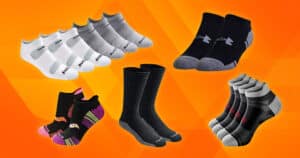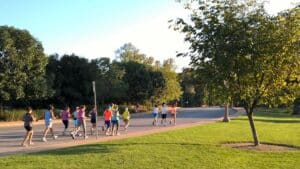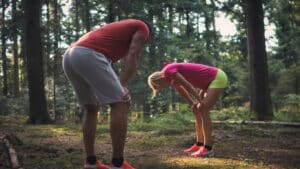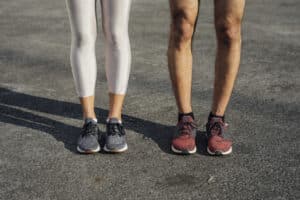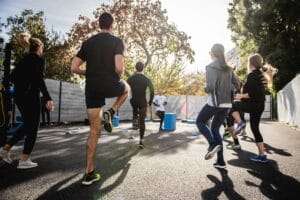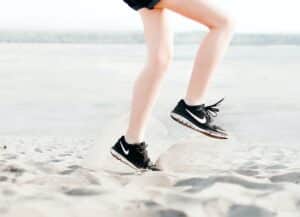It is necessary that one must warm up their body before running, playing, or doing any exercise as if we don’t do that, it can cause shin splints. Shin splints stretch before running are very important as they can avoid shin splints.
Shin splints, commonly known as tibial stress syndrome, are inflammatory of the muscles, ligaments, and shinbone surrounding your tibia. Pain is more common around the tibia’s inner side, where tendons join the bone. Shin splints are a type of shin splint that affects the inner side of the shinbone.
Runners, performers, and military veterans are all prone to shin splints. Shin splints, also known as tibial stress syndrome, are common among sportsmen who might have nearly doubled or altered their fitness routines. Muscle, ligaments, and shinbone are overworked as a consequence of rising exercise.
Resting, ice, as well as other self-care methods, can help most instances of shin splints. It can be avoided by choosing comfortable shoes and changing your activity program.
Symptoms Of Shin Splints

Soreness, stiffness, or discomfort anywhere along the inner walls of the shinbone and slight inflammation in the calf muscle are signs of shin splints. If someone quits exercise, the discomfort may go away initially. Yet, the discomfort can become chronic over time, leading to stress or stress fracture response.
When should you see a doctor?
See your physician if resting, ice, and pain medicines really do not help your shin discomfort.
Causes
Shin splint can be caused by the repeated pressure around the shinbone and the connective tissues connecting the muscle bones.
Don’t forget to check Best nike shoes for shin splints.
Factors That Are At Risk
Shin splints can affect you more if you:
• You’re an athlete, especially one who is just starting out.
• You abruptly increase the length, duration, or intensity of your workouts.
• You run on various surfaces, including hills and hard surfaces like concrete.
• You’ve enlisted in the military.
• You have high arches or flat feet.
Prevention
The following methods can prevent shin splints.
Examine Your Movement
• The best way to examine your running movement is by recording a video of you running and then comparing it with the videos on the internet. You can figure out the patterns that may contribute to shin splints.
If you closely analyze it and change your running patterns, you can easily decrease the risk of shin splints.
Don’t Overdo
• Many people start overdoing exercise, or even beginners don’t have adequate knowledge and overwork themselves with workouts without paying much heed to consequences.
Overdoing can be a factor that can cause shin splints.
Suitable Shoes
• It is vital that one must select the right and comfortable shoes for running or doing any physical exercise. It is also recommended that every runner must change their shoes after every 350 to 500 miles.
Think About Arch Support
• Orthotics or arch support must be considered if you’ve flat feet, as it can help you walk and run and decrease the risk of a shin splint.
Shock-Absorbing Insoles
• Many athletes and runners use shock-absorbing insoles to reduce the risk of shin splints.
Strength Training
• It is very important that one must add at least strength training in the workout training as by doing so, you can easily do heavy workouts and sports.
Reduce The Impact
• If you’re a newbie, then you must start with an exercise that doesn’t put much pressure on your shin. Like cycling, swimming, or walking and gradually increase the timings and intensity.
General Stretch
• Gradually slide into stretching position until a tightness of roughly 7 out of 10 is felt.
• If you experience distress, you’ve gone further than just the stretch; instantly stop.
• While resting and taking a deep breath, keep the stretch posture for 15-seconds.
• If required, cautiously exit the stretching and repeat the stretching on the opposing side.
• Rep two to three times more.
• If you’re in discomfort after you’ve finished exercising, you’ve stretched excessively.
Leaning Heel Back Calf Stretch
• Leaning against a wall while standing erect.
• Put your leg as close to the wall as possible while keeping both toes looking forth and your heels on the floor.
• Lean on the wall with your right leg straight.
• Ensure your rear leg’s toes are pointing front.
• This exercise will exert unequal stress mostly on calf muscles if your toes tilt-only one way.
• It could result in a muscular imbalance if done for a long time.
Achilles Tendon Seated Stretch
• Bent one knee and extend the other foot in front of yourself, keeping the foot on the ground while sitting on the ground.
• Around the sole of the foot, wrap a fitness band, a cloth, or a belt.
• Bring the heel gradually and stay for 15-30 seconds—rep 2–4 times more.
• This stretching may also be done sitting in the chair with one leg outstretched with your foot on the ground. Bring the heel towards you by looping the bands or cloth over your foot.
Steps-ups
• Step-ups help in strengthening your buttocks, which are important for bearing stress while the running flexion.
• Look for a stair that is several inches below your knee
• Put one leg on the stair and rise up, lifting your knees into a jogging stance while avoiding pushing off by your back leg.
• Gradually decrease your leg to the floor and switch sides 10-12 times.
Box Calf Raise
• Place a box or a safe step stool against a wall, or some people also do this exercise on the stair’s first step.
• Stand atop the box with your heels dangling over the side.
• Raise your feet to the ground and your toes to the air as you lower the weight.
• Lift up to the tippy-toes and stretch your calves.
• Allow your weight to gradually return to normal (step 3) so that your calves are relaxed once again.
• Rep for a total of 10–12 sets.
EXTRA: You can also try single leg calf raise but make sure to hang onto something for support.
Bended Ankle Flexion
• You could use a stretchy resistance band that you would put over your foot for this exercise.
• Put the elastic over your foot’s top and secure it to a fixed place next to you.
• Begin by flexing your feet and pointing your foot outwards.
• When you put your foot on the floor, the band would feel tight.
• Bring your heel at you and arch your toes, allowing the elastic to relax a little.
• After transferring to the other heel, continue 15–20 rounds.
Seated Shin Stretch
• This stretching focuses on the tendons at the rear of the calf muscle, which can relieve shin discomfort.
• Start by squatting and slowly sitting down such that the feet are precisely under the buttocks and the knees are squarely in the front.
• Bend slightly downward and put your hands on the ground before you.
• To experience the stretching, carefully press down on the feet with the entire weight.
• To put more pressure, raise your right knee off the floor.
• Stay in this position for 30 seconds. Return to the starting position and rep up to three times more.
Foot Rolling
Foot rolling can relieve shin splint discomfort by reducing inflammation. A method for “rolling” off the shins is as follows:
• Put your forefoot on a ball.
• Move the ball of the feet from the left side to the right side, beginning with the toenail, to gradually extend your joints.
• To regulate the stress, gently move to and fro over the ball while maintaining your feet on the ground on the sensitive parts of your sole.
• This must be done for 2-3 minutes.
• If desired, switch legs.
Also check Running Form to Prevent Shin Splints
Conclusion
We hope that you’ll follow these exercises before starting your next workout. This shin splint stretches before running are very important as they can prevent inflammation of muscles and shin splint discomfort.
We’ve also attached the link with some of the exercises to make it easier for you.
We recommend you to make your proper exercise routine and follow it strictly so that it won’t be a problem for you as some people may face difficulties when they make changes in their workout routine.









